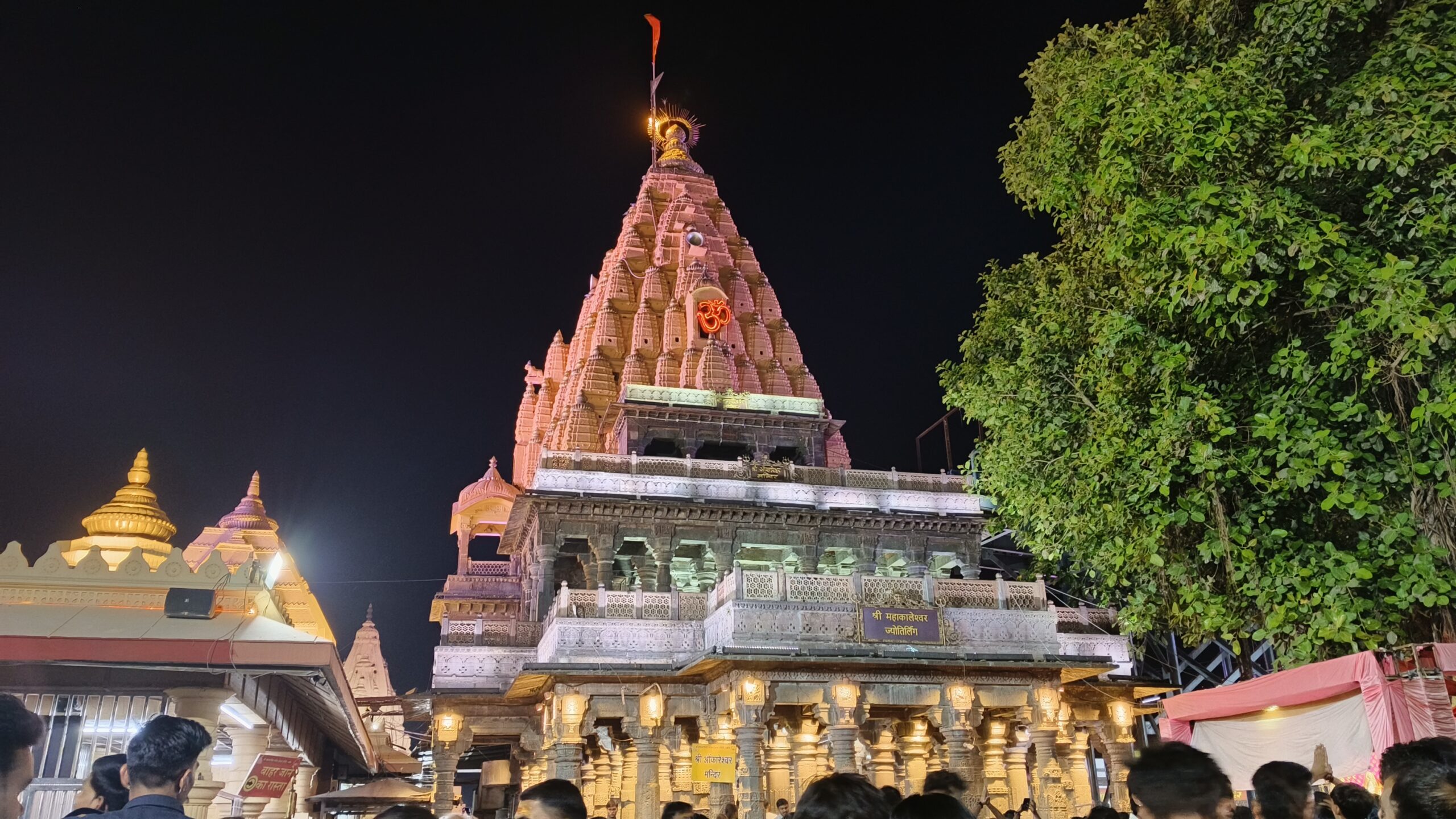The journey to Mahakaleshwar Temple begins long before you reach the temple gates. It starts in the narrow lanes of Ujjain’s old city, where the air grows thick with the scent of marigolds and incense. The sound of chanting grows louder with each step, mingling with the rhythmic ringing of temple bells. Then comes the moment when the ordinary world falls away—a sudden shift in the atmosphere as you cross the threshold into a space where time itself seems to breathe differently.
Unlike other temples that feel like sanctuaries apart from the world, Mahakaleshwar Temple is woven into the very fabric of the city. The temple doesn’t stand on a hilltop overlooking the landscape; it sits at the heart of Ujjain, surrounded by bustling markets and narrow residential lanes. This isn’t a place you visit to escape the world—it’s a place where the divine pulses through everyday life.
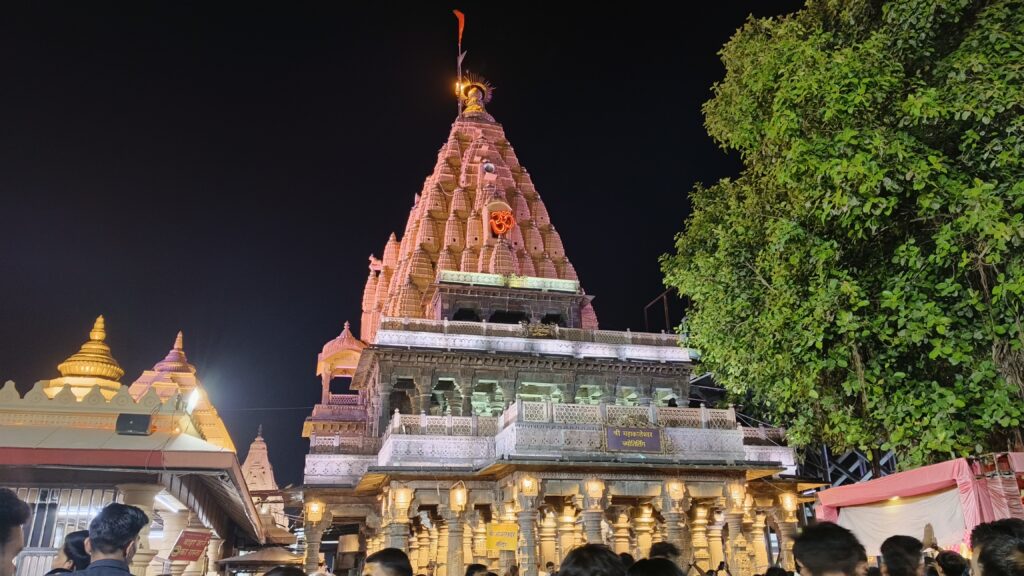
As the shoes come off and bare feet touch the cool marble floor, something shifts. The air grows heavier, charged with centuries of devotion. The first thing that strikes you isn’t the grandeur of the architecture, but the intensity of the energy—a palpable vibration that seems to resonate through the stone itself. This isn’t just another temple; it’s a living embodiment of time’s eternal cycle, where Shiva reveals himself as Mahakal, the Lord of Time who both creates and destroys.
The Ancient Heartbeat of Ujjain
Mahakaleshwar Temple history stretches back beyond recorded time. While the current structure dates primarily to the 18th century (rebuilt after repeated destruction), the site’s sanctity is ancient. Ujjain itself was one of the seven sacred cities of Hinduism long before the Mauryan Empire, mentioned in the Vedas as Avantika. The temple’s location at the center of the city isn’t accidental—it sits at the precise point where the ancient meridian of Ujjain intersects with the Tropic of Cancer, making it a cosmic axis point in traditional Indian astronomy.
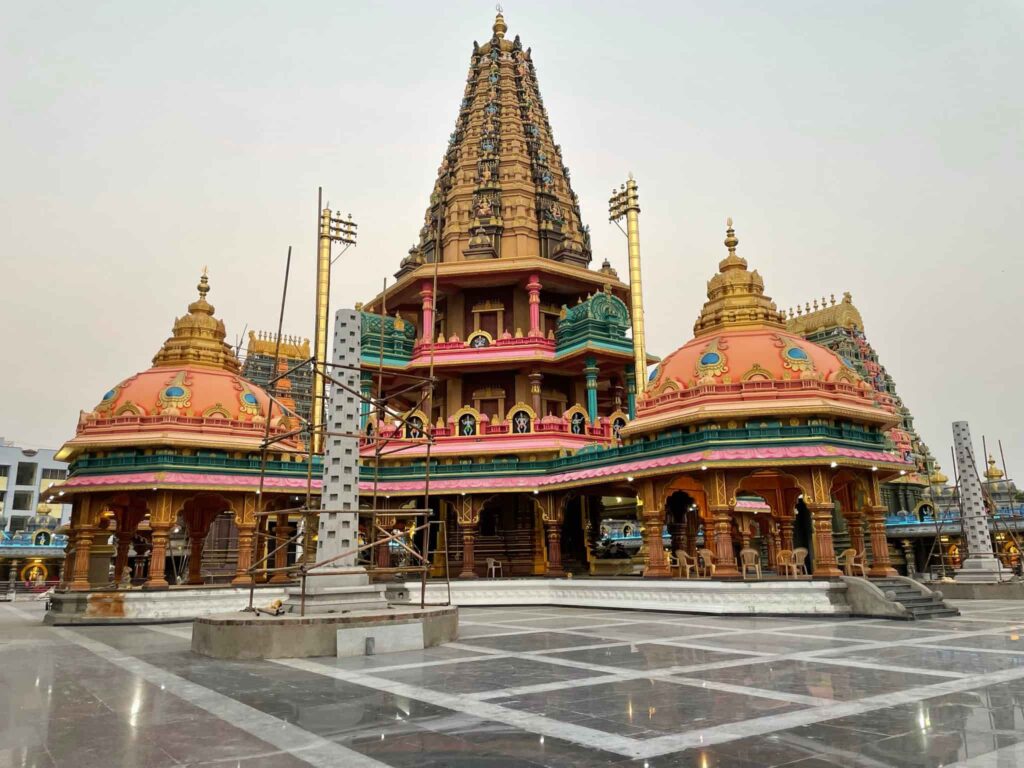
The legend tells of a boy named Shrikar who, witnessing King Chandrasena’s devotion to Shiva, began worshiping a lingam formed from sand on the banks of the Rudra Sagar lake. When demons attacked the kingdom, Shiva emerged from the lingam to protect his devotees. The lingam then manifested as a self-born (Swayambhu) form, establishing Mahakaleshwar Temple as one of the twelve Jyotirlingas—the most sacred Shiva temples in India.
What makes Mahakaleshwar Temple unique among the Jyotirlingas is its orientation. While most temples face east, Mahakaleshwar faces south—a rare configuration that signifies Shiva’s aspect as the conqueror of death. This southern orientation connects the temple to the realm of Yama, the god of death, reinforcing Shiva’s role as Mahakal, who transcends even death itself.
The Architecture of Time
The temple’s architecture reflects its cosmic significance. Built in the Bhumija style of North Indian temple architecture, the complex follows a precise geometric pattern that mirrors the Hindu conception of the universe. The main structure rises in concentric squares, each representing a different cosmic plane, culminating in the central sanctum where the Jyotirlinga resides.
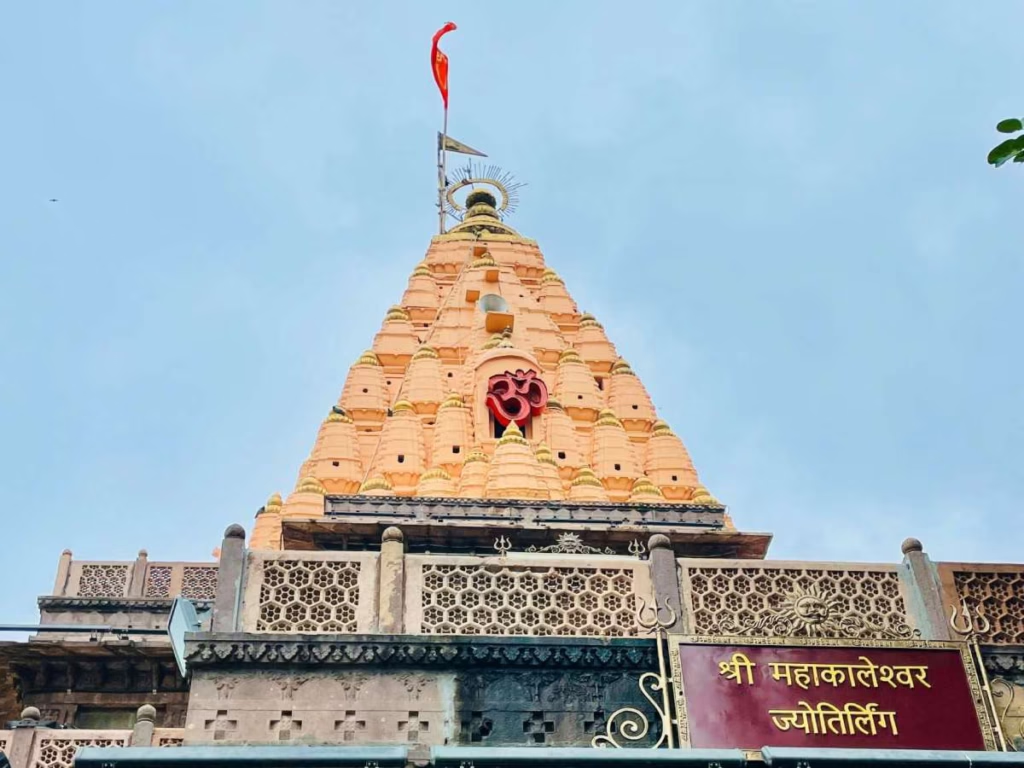
Unlike the ornate temples of South India, Mahakaleshwar’s beauty lies in its simplicity and symmetry. The outer walls are relatively plain, focusing attention inward toward the sacred center. The five-story structure is crowned by a golden spire that catches the first rays of dawn, illuminating the entire complex in golden light.
The temple layout follows a precise pattern:
- The outer courtyard: Where devotees gather and prepare for darshan
- The inner courtyard: Housing smaller shrines to various deities
- The Nandi Mandap: Where the sacred bull faces the main sanctum
- The five-story structure: Each level representing a different aspect of consciousness
- The underground sanctum: Where the Jyotirlinga resides, below ground level
This downward orientation is significant—the Jyotirlinga isn’t elevated on a platform but rests in a natural depression, as if emerging from the earth itself. This placement connects Mahakaleshwar to the ancient concept of the divine as something that rises from the earth rather than descending from the heavens.
The Jyotirlinga: Pillar of Light That Never Dies
Among the twelve Jyotirlingas, Mahakaleshwar holds a special place. The term “Jyotirlinga” means “pillar of light,” referring to the legend of Shiva manifesting as an infinite column of light to settle a dispute between Brahma and Vishnu. These twelve sites represent where fragments of that divine light took physical form.

What makes Mahakaleshwar unique:
- It’s the only Jyotirlinga that is a “Swayambhu” (self-manifested) lingam
- The southern orientation connecting it to Shiva’s aspect as conqueror of death
- The underground location of the sanctum
- The powerful energy that devotees say intensifies at specific astrological moments
- The belief that worshiping here liberates devotees from the cycle of time
Standing before the Jyotirlinga, the difference is palpable. Unlike sculpted lingams in other temples, this one appears naturally formed—jagged and irregular, as if it had simply emerged from the earth. The air around it feels charged, heavy with the weight of centuries of devotion. During darshan, the only light comes from oil lamps that flicker against the ancient stone, creating dancing shadows that seem to come alive in the dim light.
The energy here feels different from other Jyotirlingas—not the expansive energy of Somnath by the sea, nor the mountain intensity of Kedarnath, but something deeper, more primal. It’s as if standing here puts you in direct contact with the pulse of time itself, the eternal rhythm that underlies all existence.
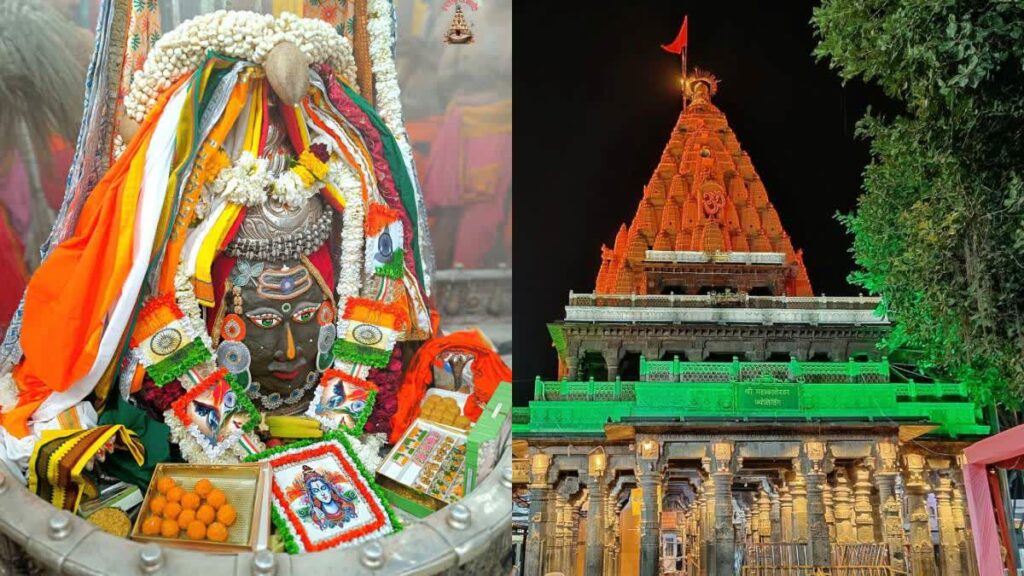
The Bhasma Aarti: Where Ash Becomes Light
The most famous ritual at Mahakaleshwar is the Bhasma Aarti, performed daily at 4 AM. Unlike the colorful aartis at other temples, this ceremony uses sacred ash (bhasma) instead of lamps. The ritual reenacts the moment when Shiva, after consuming the world’s poison, covered himself in ash to cool his burning throat.
The preparation begins before dawn. Priests gather sacred ash from ritual fires, mixing it with water from the nearby Shipra River. As the first light of day begins to filter into the underground sanctum, the ceremony begins with the ringing of bells and the sounding of conch shells.
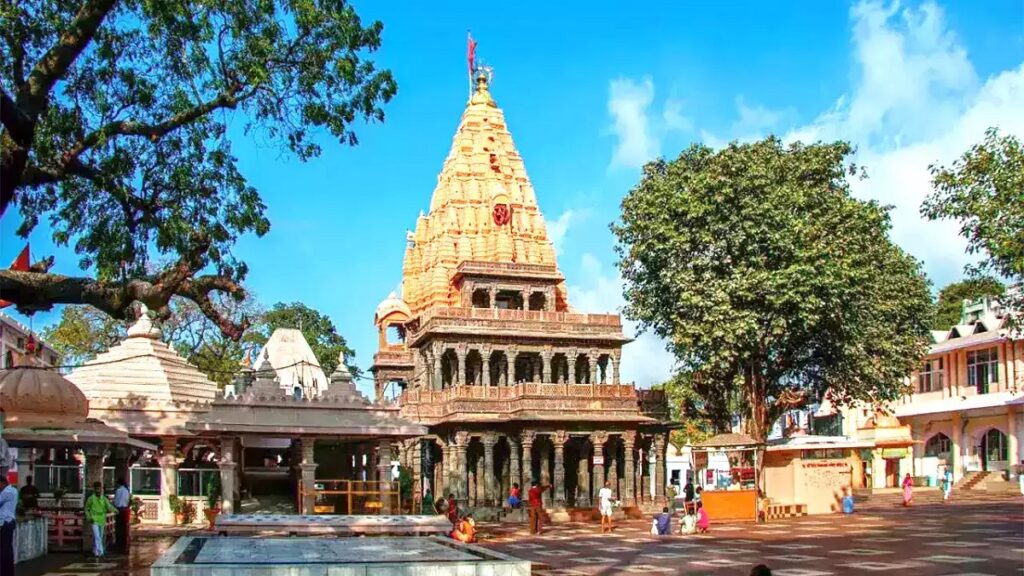
What makes the Bhasma Aarti unique:
- It’s performed in complete darkness except for the oil lamps illuminating the lingam
- The ash is applied to the lingam with precise hand movements that follow cosmic patterns
- The chanting follows a specific rhythm that corresponds to astrological alignments
- Devotees receive the sacred ash on their foreheads as prasad
- The ceremony connects to the Tantric tradition of using ash as a symbol of transformation
During the ceremony, the air fills with the scent of sandalwood and ash as priests move with practiced precision. The chanting creates a vibration that can be felt in the bones, while the flickering lamps cast dramatic shadows on the ancient walls. As the ash is applied to the lingam, it seems to glow with an inner light, as if absorbing the energy of the ritual.
The most powerful moment comes when the main priest lifts a large lamp to illuminate the lingam, revealing it coated in sacred ash. In that instant, the Jyotirlinga appears to radiate its own light—a sight that has moved countless devotees to tears throughout the centuries.
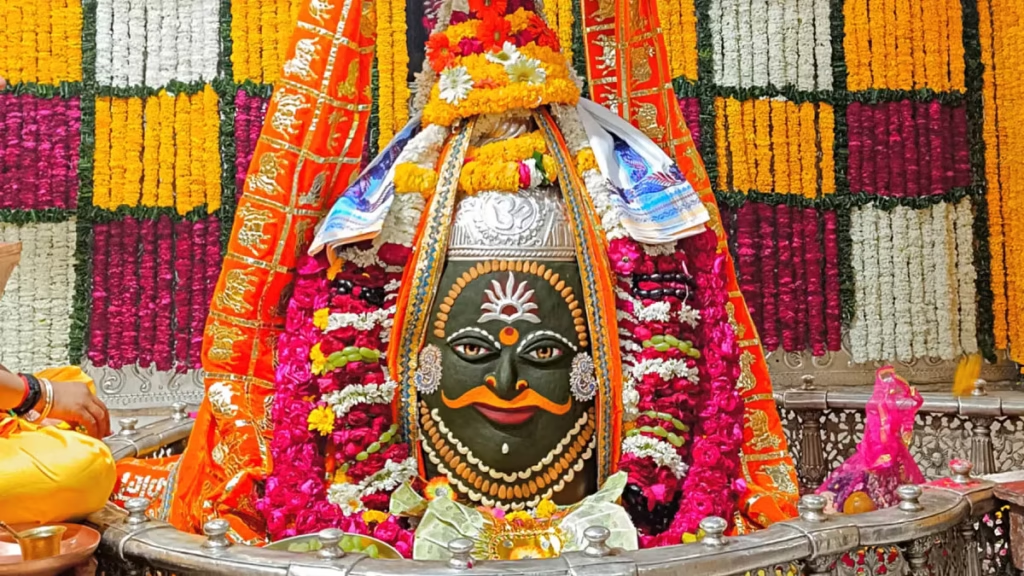
The Energy Field: Feeling Time Itself
What most guidebooks fail to capture is the unique energy field of Mahakaleshwar. Unlike temples where the energy feels expansive or uplifting, Mahakaleshwar’s energy is deep and grounding—a sensation many describe as “feeling time itself.”
Visitors often report:
- A sudden drop in temperature when entering the underground sanctum
- A vibration in the chest area when standing near the lingam
- A sense of time slowing down or becoming irrelevant
- Vivid dreams or insights after extended darshan
- A feeling of being simultaneously small and connected to something vast
This energy is most intense during specific times:
- During the pre-dawn Bhasma Aarti
- At noon, when the sun is directly overhead
- During eclipses and other significant astrological events
- On Mondays (dedicated to Shiva) and during the month of Shravan
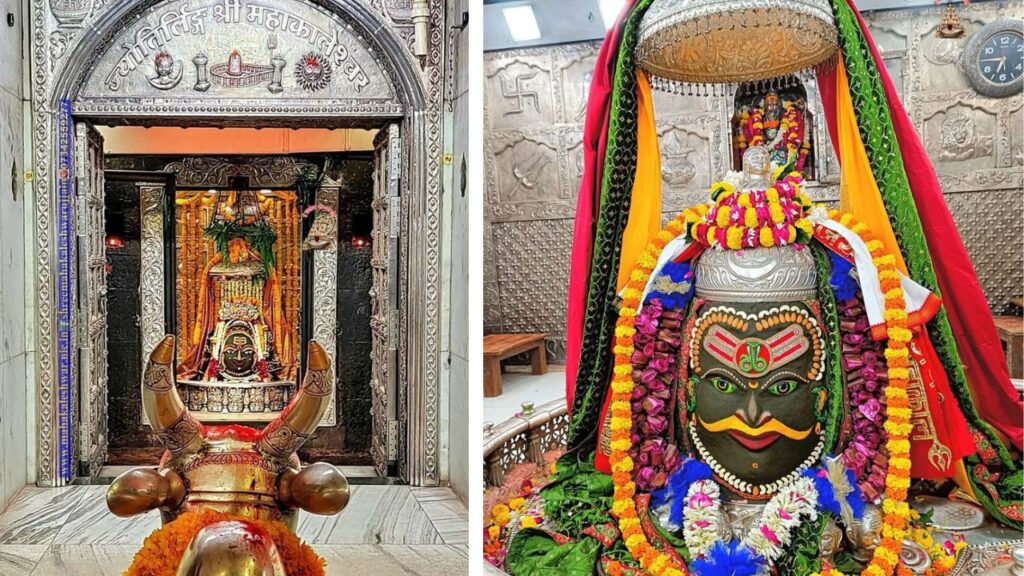
Scientists have attempted to measure this energy field, noting unusual electromagnetic readings in the underground sanctum. But for devotees, the experience transcends scientific explanation—it’s a direct encounter with the divine as the underlying rhythm of existence.
The Living Tradition: More Than Stone and Ritual
Mahakaleshwar isn’t frozen in the past—it’s a living tradition that has evolved while maintaining its core essence. The temple functions as both a spiritual center and a community hub, with activities happening around the clock:
- Morning: Devotees gather for the Bhasma Aarti, followed by the regular morning rituals
- Midday: The temple becomes a gathering place for scholars and spiritual seekers
- Afternoon: Pilgrims from across India arrive for darshan
- Evening: The regular aarti ceremony with lamps and chanting
- Night: Continuous chanting and meditation sessions
What makes this tradition special is how seamlessly it integrates with daily life. Office workers stop to offer quick prayers before work, students perform puja between classes, and shopkeepers incorporate temple rituals into their business routines. The temple isn’t separate from the city—it’s the city’s spiritual heartbeat.
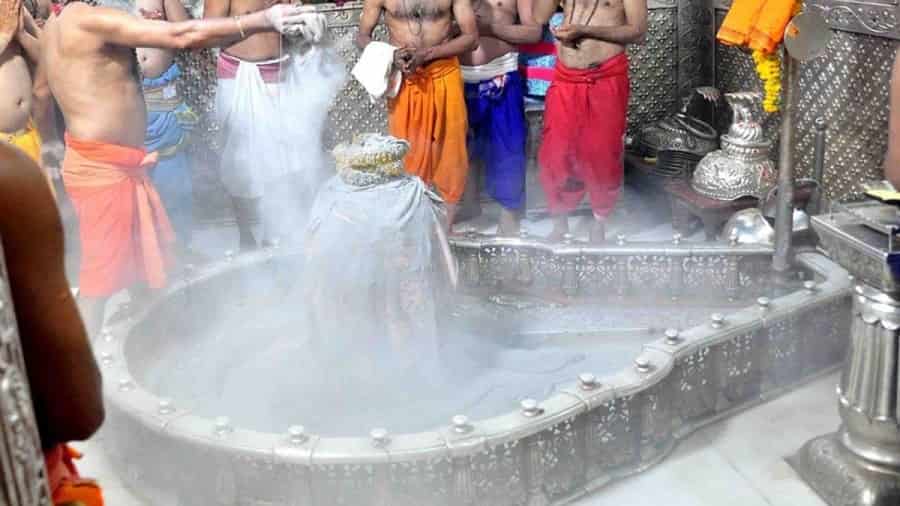
One of the most moving aspects is the tradition of “Bhasma Snan”—the ritual bathing of the lingam with sacred ash. Unlike the milk and water offerings at other temples, this ritual connects to Shiva’s aspect as the ascetic who renounces worldly comforts. The ash represents both destruction and renewal—the understanding that from death comes new life.
The Shipra River: The Liquid Manifestation of Time
No visit to Mahakaleshwar is complete without understanding its relationship to the Shipra River. Unlike other Jyotirlingas that sit by rivers (like Rameshwaram by the sea or Trimbakeshwar by the Godavari), Mahakaleshwar’s connection to the Shipra is particularly significant.
The Shipra River represents the flow of time itself. Its name comes from the Sanskrit word “shipra,” meaning “quick” or “rapid,” symbolizing time’s swift passage. The river flows in a unique north-south direction near Ujjain, reinforcing the temple’s connection to cosmic rhythms.
During the Kumbh Mela (which occurs in Ujjain every 12 years), millions gather to bathe in the Shipra, believing the river’s waters become charged with special energy. But even on ordinary days, the river holds significance:
- Pilgrims collect water from specific ghats for temple rituals
- The river’s flow is believed to correspond to cosmic cycles
- Certain bends in the river are considered especially sacred
- The water is used in all temple rituals, connecting the divine to the earthly
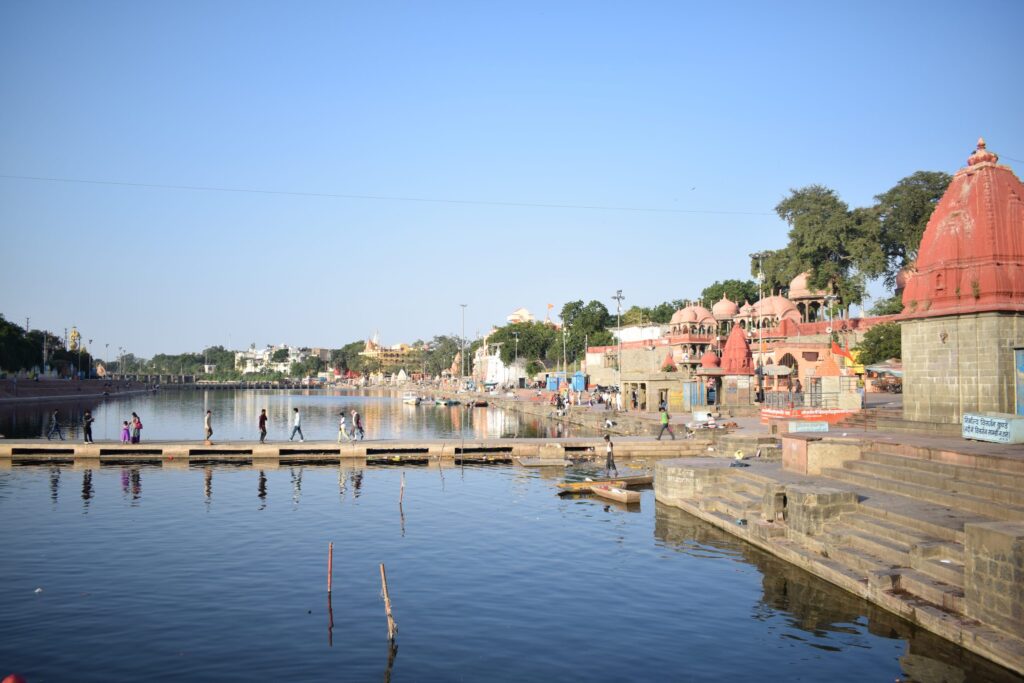
Walking along the ghats at dawn, watching the first light hit the water as devotees perform their morning rituals, one understands why this river is considered sacred—it’s not just water, but the physical manifestation of time’s flow, connecting the eternal to the temporal.
The Hidden Layers: What Most Visitors Miss
Beyond the main temple complex lie layers of history and spirituality that most visitors overlook:
The Secret Passages
The temple has a network of underground passages that were used during times of invasion. Some lead to the Shipra River, others to nearby temples. These passages aren’t open to the public, but their existence speaks to the tem
ple’s turbulent history—destroyed and rebuilt multiple times, yet the sacred site never abandoned.
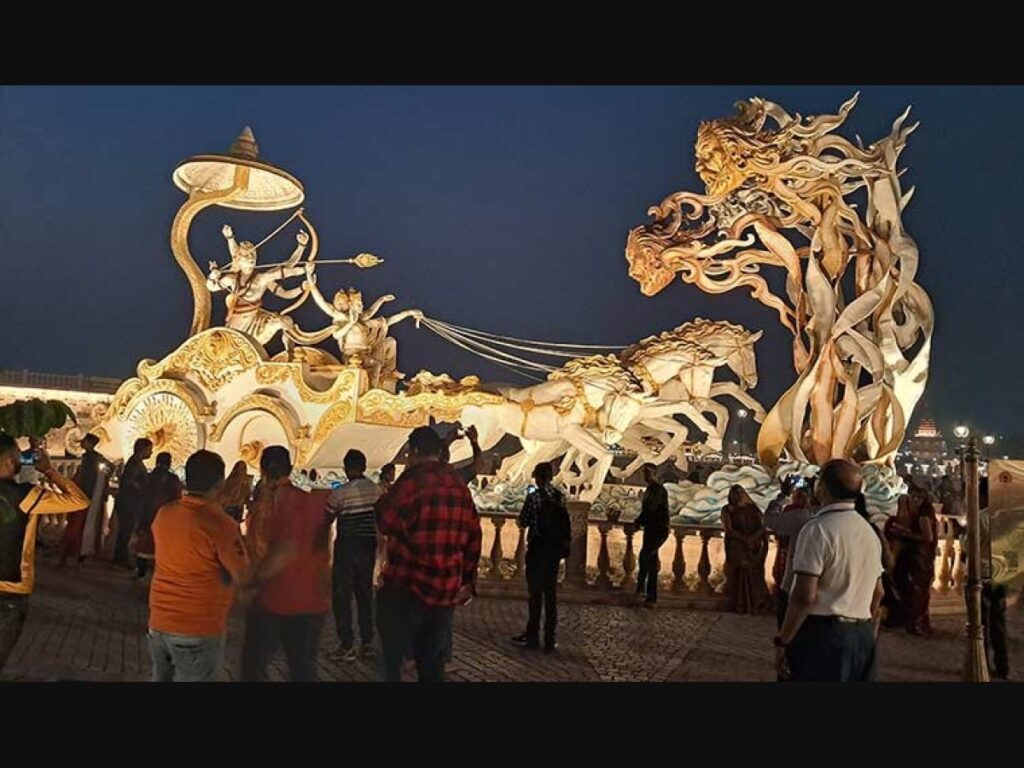
The Sound Garden
Behind the main temple, a small courtyard features stone pillars that produce different musical notes when struck. This ancient “temple of sound” demonstrates the connection between vibration, music, and spirituality in Hindu tradition. The pillars are tuned to specific frequencies believed to align with cosmic rhythms.
The Time Stones
In a rarely visited section of the temple, ancient stone markers track the movement of the sun and stars. These astronomical instruments, built into the temple architecture, show how the temple functions as both a place of worship and an observatory—connecting earthly rituals to cosmic events.

The Healing Courtyard
A small courtyard to the east of the main complex features medicinal plants used in traditional healing practices. For centuries, the temple has been a center of Ayurvedic medicine, with specific plants grown for ritual and medicinal purposes. The connection between physical and spiritual healing remains strong here.
Visiting Mahakaleshwar requires more than just showing up—it’s an experience that demands preparation and respect:
Best Times to Visit
- Pre-dawn (3-5 AM): For the Bhasma Aarti ceremony
- Late morning (10 AM-12 PM): When the temple is less crowded
- Evening (5-7 PM): For the regular aarti ceremony
- Mondays and during Shravan month: For special rituals
What to Wear
- Traditional Indian clothing is preferred (dhoti/kurta for men, saree/salwar kameez for women)
- Shoulders and knees must be covered
- Remove all leather items (belts, wallets, etc.)
- Go barefoot inside the temple complex
Ritual Etiquette
- Silence is expected in the inner sanctum
- Photography is prohibited in many areas
- Offerings should be purchased from temple-approved vendors
- Follow the clockwise movement around the sanctum
Hidden Gems
- The rooftop at dawn offers panoramic views of the temple complex
- The eastern courtyard during full moon has special energy
- The small shrine to Nag Devta (serpent god) is believed to have healing properties
- The sound garden behind the main temple is most active in the early morning
The Spiritual Significance: Beyond Ritual
At its core, Mahakaleshwar represents the understanding that time isn’t our enemy but our teacher. In a world obsessed with controlling time—scheduling every moment, racing against the clock—this temple offers a different perspective: time as a sacred river to be flowed with, not fought against.
The experience here transforms one’s relationship with time:
- Past: Not something to regret, but a foundation to build upon
- Present: Not something to rush through, but to experience fully
- Future: Not something to fear, but to approach with faith
This understanding manifests in subtle ways. Devotees don’t just come here to ask for blessings—they come to realign themselves with time’s natural rhythm. The temple teaches that true liberation (moksha) comes not from escaping time, but from understanding one’s place within its eternal flow.
The Living History: Destruction and Rebirth
Mahakaleshwar’s history mirrors the cosmic cycles it represents—creation, preservation, and destruction. The temple has been destroyed and rebuilt multiple times:
- First destruction: By the army of Shakti ruler during the 7th century
- Second destruction: By the army of Qutb-ud-din Aibak in the 12th century
- Third destruction: By the army of Iltutmish in the 13th century
- Current structure: Built in the 18th century by the Maratha general Ranoji Shinde
What’s remarkable isn’t just that the temple was rebuilt, but that the sacred site was never abandoned. Even when the stone structure was destroyed, devotees continued to worship at the location, often with simple structures or even just at the spot where the lingam had been. This continuity of devotion across centuries speaks to something deeper than architecture—it’s a testament to the unbroken thread of faith that connects generations.
The Modern Experience: Ancient Wisdom in Contemporary Times
In today’s fast-paced world, Mahakaleshwar offers something increasingly rare—a space where time slows down. Despite the crowds, there’s a palpable sense of calm that permeates the temple complex. People move with purpose, not haste. Conversations happen in whispers, not shouts.
The temple has adapted to modern times while maintaining its essence:
- Digital queue systems manage the crowds without disrupting the sacred atmosphere
- Audio guides in multiple languages explain the rituals without breaking the silence
- Medical facilities serve pilgrims while respecting the spiritual environment
- Educational programs connect ancient wisdom to contemporary life
What’s most striking is how the temple serves as a bridge between generations. Elderly devotees sit side by side with young students, sharing the same space and the same devotion. The temple isn’t stuck in the past—it’s a living tradition that continues to evolve while maintaining its core essence.
The Inner Journey: What Mahakaleshwar Teaches
More than any ritual or architectural detail, Mahakaleshwar offers profound lessons about existence itself:
Time as Teacher
The temple teaches that time isn’t our enemy but our greatest teacher. The constant flow of devotees through the temple—each with their own joys and sorrows—reminds us that all experiences are temporary. The same space that holds someone’s deepest grief today will hold someone’s greatest joy tomorrow.
The Cycle of Creation and Destruction
Standing before the Jyotirlinga, one understands that creation and destruction aren’t opposites but parts of the same cycle. The Bhasma Aarti, with its emphasis on ash, teaches that from destruction comes new creation—a lesson increasingly relevant in our rapidly changing world.
The Eternal Present
Despite its connection to time, the deepest experience at Mahakaleshwar happens when time falls away completely. In moments of deep meditation before the lingam, past and future dissolve, leaving only the eternal present—a taste of the timelessness that lies beyond time.
Unity in Diversity
The temple welcomes people from all backgrounds, castes, and religions. The continuous flow of diverse devotees through the sacred space teaches that beneath our differences, we share the same longing for connection to something greater than ourselves.
FAQs on Mahakaleshwar Temple
1. Where is Mahakaleshwar Temple located?
Mahakaleshwar Temple is situated in Ujjain, Madhya Pradesh, on the banks of the holy Shipra River.
2. Why is Mahakaleshwar Temple famous?
It is one of the 12 Jyotirlingas of Lord Shiva and the only Jyotirlinga where the deity faces south, earning it the name Dakshinamukhi.
3. What is special about Mahakaleshwar Temple?
The temple is renowned for its Bhasma Aarti, where the idol is worshipped with sacred ash every morning before sunrise.
4. What are the temple timings?
The temple opens around 4:00 AM and closes at 11:00 PM, with multiple darshan and aarti sessions throughout the day.
5. How can I attend the Bhasma Aarti?
Devotees need to register online or offline in advance as only a limited number of people are allowed to attend the Bhasma Aarti.
6. How can I reach Mahakaleshwar Temple?
Ujjain is well connected by road and rail. The nearest airport is Indore (55 km away). From there, taxis and buses are available to Ujjain.
7. What is the best time to visit Mahakaleshwar Temple?
The best time is during October to March for pleasant weather. Festivals like Maha Shivaratri and Nag Panchami are especially significant.
8. Is online booking available for darshan and sevas?
Yes, devotees can book darshan slots, aartis, and special pujas through the official temple website.
9. Are accommodations available near Mahakaleshwar Temple?
Yes, Ujjain offers several Dharamshalas, guest houses, and hotels near the temple premises.
10. Can non-Hindus visit Mahakaleshwar Temple?
Yes, non-Hindus can enter the temple premises, but the Garbhagriha (sanctum sanctorum) is reserved only for Hindus.

